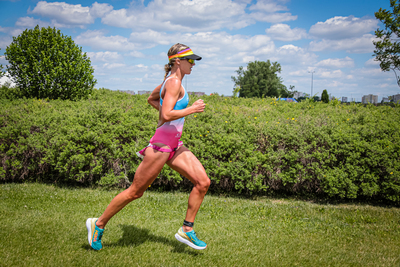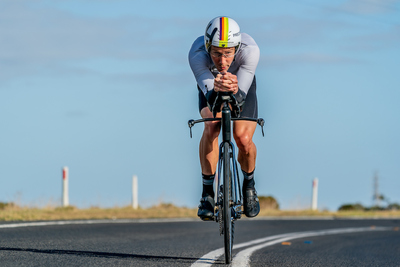The IRONMAN® World Championship in Kona, Hawaii, always showcases epic racing. The race also features spectacular meltdowns from some of the world’s best endurance athletes. Sure, some meltdowns are caused by a “go big or go home” style of racing, but Kona’s extreme heat and humidity takes a toll on many athletes.
This article focuses on heat training to prepare for Kona or any other hot race. Keep in mind, thermoregulation is important regardless of the ambient temperature. When you work hard, your core temperature climbs. But in a hot climate, it can quickly spiral to unsustainable levels, so preparing yourself with heat training is essential...
What happens when you overheat?
When athletes overheat, their performance suffers. As your temperature climbs, the body diverts blood from the muscles toward the skin for cooling. This diversion means that less blood (and less oxygen) is delivered to the muscles, so those muscles produce less power and acquire more fatigue than if they were cooler.
This performance decline happens well before the onset of heat exhaustion, and even before many athletes feel overly hot or are aware that their performance is suffering.
Research shows performance degradation at core body temps as low as 38.5°C (101.3°F). This is a relatively low temperature; truly elite athletes may even reach core temps of as high as 41.5°C / 106.7°F while racing in hot conditions.

The benefits of heat training
Heat training causes numerous physiological adaptations, many of them centred around increased blood plasma. Heat training often results in a reduced resting core temp, a faster onset of sweating, an increased maximal sweat rate, a reduced resting and exercising heart rate, a reduced rate of muscle glycogen utilisation, and an increased lactate threshold.
All of these adaptations result in increased performance, in both hot and cool conditions. Those wanting to fully understand the physiology of heat training should read this comprehensive paper.
What is heat training?
To help prepare for racing in hot conditions, heat training is repeated daily exposure to conditions that elevate the core body temperature to a level that causes adaptions. This can be done by a combination of the following to achieve the target of getting all hot and sweaty for endurance gains:
- Exposure to high ambient temperatures/humidity
- High exertion levels
- Wearing extra clothing
Historically, heat training has been a very imprecise tool. For many athletes, heat training mostly consisted of sweating a lot and trying not to overcook themselves. However, if they didn’t elevate their core temperature high enough (and frequently enough), they didn't adapt. And if they elevated it too high (or for too long), they found themselves exhausted for days. The risk of heat exhaustion, heat injury, or even heat stroke has always been an issue during imprecise heat training.
What is precision heat training?
Precision heat training involves determining an athlete’s individual heat training zone – the core body temperature where heat adaption occurs without causing too much strain on the body. The athlete then accumulates a prescribed amount of time in that heat training zone. SSports scientists call this “controlled hyperthermia”, and according to the literature, it is an effective method for inducing heat adaptations. Although there is evidence that if other controls are implemented (intensity, environmental conditions) adaptations to the heat and performance gains will occur without the need for controlled hyperthermia .
Precision heat training has often involved using rectal probes or swallowable electronic pills to monitor core temperature. But the cost and invasiveness of these techniques meant these were really only accessible to laboratories and extremely well-funded athletes.
In the past couple of years, technological advances have made precision heat training a more convenient and affordable tool for athletes. For example, the CORE body temperature sensor is a small wearable, non-invasive sensor that accurately records core body temperature data. Clipped to a heart rate monitor strap, it seamlessly connects to a smart watch, bike computer or phone, giving the athlete real-time, continuous core temp readings.

How to approach heat training
Athletes conduct heat training for numerous reasons, including season-long performance gains. Here, we summarise heat training for a specific race.
Before starting heat training, it's advantageous to become familiar with different resources on the topic.
Two great reads on heat adaptation are the International Olympic Committee’s Beat the Heat guide and the International Triathlon Union’s Beat the Heat guide.
When to start
While the number of days required for heat adaption varies amongst individuals, 14 days works well for most athletes. The ITU Beat the Heat guide describes a number of scenarios based on how long in advance one arrives at the race site. For our example, heat adaption starts two-to-four weeks before the event.
Here's a step-by-step summary of how to approach precision heat training:
Step 1. Heat ramp test
Your first step is to complete a one-hour heat ramp test using a CORE sensor. This will identify your ideal heat training zone.
Step 2. Heat block training
The second step is to complete two weeks of heat block training. This involves training for 45–90 minutes each day within your heat training zone. You can undertake heat training either by exercising in a warm/humid climate, wearing extra clothes, or some combination of the two. It can also be incorporated into high intensity training days, although care should be taken to ensure adequate recovery given the increased fatigue with heat training..
Step 3. Heat training maintenance
If your two-week long heat block training ends more than a couple of days before your competition, you will need to maintain your heat training. This requires elevating your core temperature into the heat training zone for 45–90 minutes per day for one to three days a week.The longer out from a race that your heat block finishes, the more heat sessions you should include into your training each week to maintain those adaptations.
Additional steps
The steps described above are the basics of heat adaption and will drive performance improvements on race day, whilst providing useful data to help you:
Identify your threshold core temp. Learning the core temperatures you can sustain for various durations helps with race-day pacing.
Develop a hydration strategy. You can use core temp to hone your optimal intake of fluids (i.e. you’ll learn what level of dehydration causes a rise in core temp during your indoor sessions).
Determine cooling strategies. Carefully controlled trials will identify the optimal cooling strategies for different conditions.
Overcome jetlag. Core temp is closely linked to the circadian cycle. This data can help you overcome jetlag and be fully rested by race day. Learn more.
